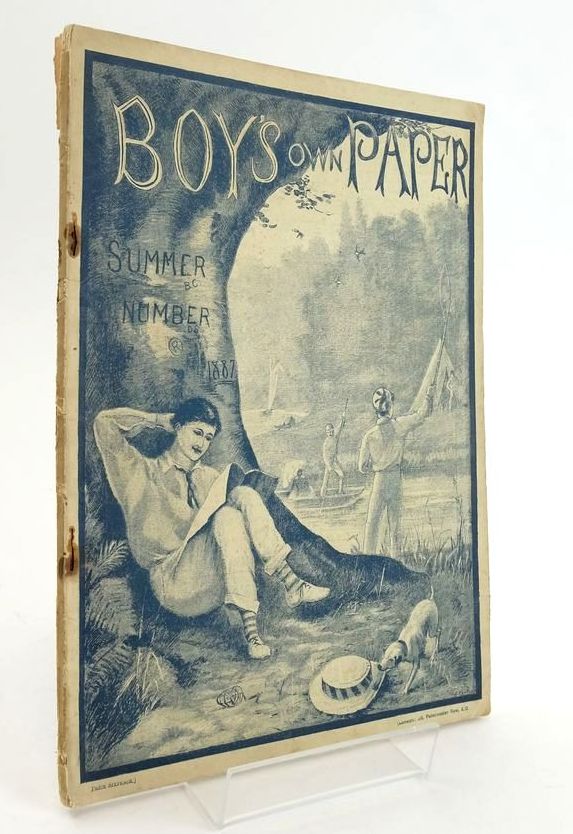BOP
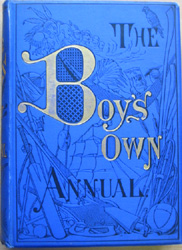 BOP - a cartoon character's punch?
BOP - a cartoon character's punch?
BOP - early modern jazz??
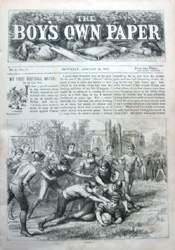 No, in fact it's Boy's Own Paper which after its founding in 1879 quickly became known as B.O.P. and has entered into English with the phrase "It's just like a story out of Boy's Own Paper" when incredible tales of heroism and derring-do are being discussed.
No, in fact it's Boy's Own Paper which after its founding in 1879 quickly became known as B.O.P. and has entered into English with the phrase "It's just like a story out of Boy's Own Paper" when incredible tales of heroism and derring-do are being discussed.
Left: The attractive cover of Volume 10 (1887-8)
The B.O.P was issued weekly by the Religious Tract Society to combat the "penny dreadfuls" of the day and was to be "pure and entertaining" reading with a steady stream of recommendations for curing impure thoughts and, much worse for boys, impure actions!
Right: Page 1 of Volume 1.
Yet, despite this moralistic start and ongoing undercurrent of Christian ethics, the B.O.P. was immensely successful with its intended audience - boys. In some cases very old boys for, in truth, the B.O.P appealed to all ages, with strong readership from "boys" in their teens through twenties and serving soldiers.
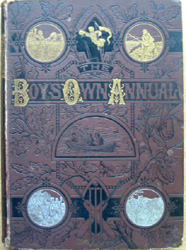 The basic themes of the B.O.P. were sport, literature and hobbies. The very first issue clearly displays the mixture that was to continue so successfully for more than 90 years. The first article is "My First Football Match" by "An Old Boy", later identified as 26 year old Talbot Baines Reed, a keen supporter of B.O.P. The very next article is by the famous natural history author the Rev. J.G. Wood. Sandwiched between the two is a poem which sums up B.O.P.'s ethics:
The basic themes of the B.O.P. were sport, literature and hobbies. The very first issue clearly displays the mixture that was to continue so successfully for more than 90 years. The first article is "My First Football Match" by "An Old Boy", later identified as 26 year old Talbot Baines Reed, a keen supporter of B.O.P. The very next article is by the famous natural history author the Rev. J.G. Wood. Sandwiched between the two is a poem which sums up B.O.P.'s ethics:
"Whatever you are, be brave boys!
The liar's a coward and slave, boys!
Though clever at ruses,
And sharp at excuses,
He's a sneaking and pitiful knave, boys"
With several more verses in a similar vein!
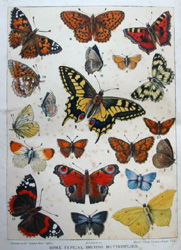 Articles on skating and consideration for animals are there, together with a story by W.H. Kingston and therein lay another of the successes of B.O.P. It attracted leading authors and in some cases discovered authors who were later to be famous. That first issue, for example, had an article by Captain Webb who was the first person to swim the English Channel.
Articles on skating and consideration for animals are there, together with a story by W.H. Kingston and therein lay another of the successes of B.O.P. It attracted leading authors and in some cases discovered authors who were later to be famous. That first issue, for example, had an article by Captain Webb who was the first person to swim the English Channel.
In addition to the weekly paper, a monthly issue was also produced, printed on good stiff paper which would stand up to wear and tear and carrying advertising front and back. While the weekly issues were read, loaned, passed around, seized back, until they were grubby and falling apart, the more robust monthly issues were kept for leisurely re-reading and future reference. From time to time the monthly issues also included a handsome presentation plate, suitable for framing.
Right: Volumes contained attractive colour plates.
The first annual volume containing all the weekly issues from January 18 to September 30, 1879, was published for Christmas that year. Thereafter each annual ran from October to October and included the colour presentation plates from the monthly issues. The first volume contained stories by Kingston and Talbot Baines Reed as well as the Rev. J.G. Wood and it was illustrated by Edward Whymper - the first person to ascend the Matterhorn! Jules Verne was a contributor, as well as Arthur Conan Doyle,G.A. Henty, Charles Gilson and R.M. Ballantyne.
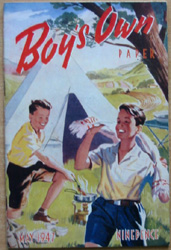 The first annual also contained a "Prize Essay" competition which accurately reflects the times and the B.O.P. It's subject was "Bird's Nesting" (the collecting of eggs from bird's nests) - anathema today but a typical hobby of its period and the age groups for the competition shows us clearly the readership:17 to 21; 14 to 17; up to 14 and, by the way, a subsequent competition was won by a 65 year old!
The first annual also contained a "Prize Essay" competition which accurately reflects the times and the B.O.P. It's subject was "Bird's Nesting" (the collecting of eggs from bird's nests) - anathema today but a typical hobby of its period and the age groups for the competition shows us clearly the readership:17 to 21; 14 to 17; up to 14 and, by the way, a subsequent competition was won by a 65 year old!
In 1914 the weekly parts were dropped and the magazine continued as a monthly. During the first world war the editor was instructed to "keep the Boys Own Annual going at all costs"! Sadly this was not the case during the second world war. Due to paper shortages the magazine was reduced dramatically in size and the last annual was produced in 1940.
B.O.P was definitely male orientated: the story Jack and John concludes with "...useless, helpless thing - a woman", although the occasional letter from a Girl suggests that sisters were reading their brothers copies. Girls had to wait until 1880 for their own magazine the Girl's Own Paper.
B.O.P did not have things all its own way. Rivals such as Chums, The Captain,Gem and Magnet were all successful but the B.O.P outlived them all. While the first issue showed no signs of becoming a British institution, its impact proved to be worldwide and its influence lasted for virtually a century.
Contributed by Chris Tomaszewski
Information gleaned from:
Take A Cold Tub, Sir, The Story of the Boy's Own Paper by Jack Cox
The Best of British Pluck, the Boy's Own Paper revisited by Philip Warner
(Published on 4th Dec 2014 )


